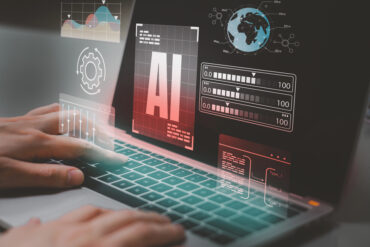
AI-enabled EHR solutions are solving operational issues and streamlining care coordination in ways that weren’t possible just a few years prior.
As the COVID-19 pandemic continues, artificial intelligence (AI) is playing a major role in addressing shifting health care demands. Doctors not only need more time to treat the surge in patients caused by the virus, but the rising use of telehealth is also increasing the complexity of the health care landscape. A faulty Electronic Health Record (EHR) platform can be the downfall of a practice, but AI is stepping in to make virtual care management seamless.
While not all virtual health solutions are created equally, physicians who have an EHR with robust AI are faring better than those that don’t. According to a study by the American Medical Association (AMA), EHR data entry is taking over more than half the typical 11.4 hour workday for physicians—a phenomenon that’s now even more unacceptable given the demanding treatment and volume of COVID-19. Fortunately, AI is helping to reduce the administrative EHR burdens that keep providers from seeing the patients that need them the most.
See also: How AI is Changing the Healthcare Industry
Managing Low Acuity Patients
Low acuity patients, or patients with minor health concerns like cough, cold, and flu, are particularly benefitting from AI. These patients are being deterred from visiting in-person clinics due to the dangers of catching COVID-19, but AI makes it possible for these patients to receive treatment nonetheless. This also comes at a benefit to providers. Before COVID-19, providers were less likely to be the recipients of low acuity revenue because people were treating themselves. Now, telehealth options make patients more likely to engage with their primary providers for seemingly minor symptoms.
While telehealth is providing patients with at-home, socially-distanced access to a physician, AI is sending reminders to help them stay on top of their treatment. This technology is letting them know when to take their medication, when to rest, and when to contact a live physician. Although most alerts are still in the form of texts and app notifications, home devices like Amazon Alexa and Google Home are exploring this application. Assist-AI existed pre-COVID, but the industry has since exploded to supplement physicians’ valuable time during the pandemic.
Improving Telemedicine Solutions
Telemedicine has done a fantastic job of providing at-home care access, but one thing that telehealth still struggles to address is the administrative process. Traditionally, forms are completed through a triage process carried out through a receptionist, nurse, then doctor flow that exists in in-person offices. Each person is responsible for their own forms, but this process had to change to fit the more straightforward structure of telehealth.
Just like AI is capable of reminding patients to do things, the same goes for health care staff. Because the triage process isn’t the same with telehealth, AI can step in to remind each employee to carry out their tasks. This includes logging into the telehealth platform when appropriate, sending patients the correct forms, delivering medical bills, and more. AI helps to simplify the overall workflow—something that’s otherwise difficult through telehealth alone.
Helping Predict Data
Predicting data and health care issues can be complex, but today’s AI can accurately predict some of the more black and white cases. AI particularly excels in the radiology field—so much so that advanced AI is sometimes even better at imaging than experts in the field. In medical fields where there are fewer variables, AI tends to be better than humans at finding and diagnosing health concerns. This finding has been confirmed in a 2019 study by the Royal College of Physicians Future Healthcare Journal, in addition to several others.
Because of AI’s ability to analyze and predict patient data, it can illuminate underlying health conditions that would’ve otherwise gone unnoticed and untreated. AI can help examine a patient’s existing conditions and uncover patterns in a person’s health. For example, if a patient who was being treated for pancreatic cancer also had heart palpitations, the AI can inform physicians whether the heart palpitations are a cause for concern. While this is true, it’s critical to note that AI is not replacing doctors anytime soon. AI can assist, but it can’t replace them.
The Ideal Health Care AI Landscape
With patients and providers being forced to use virtual health care platforms due to COVID-19, the amount of data being captured has vastly exceeded in-person data collection. With mass digitization, EHR solutions can leverage this data to make health care operations more intuitive and efficient. When AI provides the EHR with more data to crunch, the technology can learn faster to improve systems and processes.
Another key attribute of an ideal AI application is technological interoperability. It’s not uncommon in health care for technologies like EHRs, telehealth platforms, revenue cycle management software, and others to have no ability to communicate with one another. This has consequences for both patients and providers alike—when a care practice doesn’t have interoperable technology, critical patient information can slip through the cracks, billing can take months longer, and patients can notice operational inefficiencies.
Clinics that have interoperable software solutions have also been much more adept at responding to changing needs in the health care landscape. This has been made especially apparent by COVID-19. As patients are being forced to stay home or go to unfamiliar facilities due to the pandemic, clinics that have stronger data exchange are better able to treat those patients than those that relied on common but outdated EHR systems. Additionally, interoperable systems make it easier to change technology as necessary.
The EHR Difference
AI-enabled EHR solutions are solving operational issues and streamlining care coordination in ways that weren’t possible just a few years prior. AI can do more with fewer human resources by allowing providers to see more patients, reducing in-person staff, and by billing faster and more accurately. With robust AI, practices can also maximize their number of providers—something that’s proving to be critical as patient populations are increasing.
While AI is the future of healthcare, its key to remember the technology is still maturing. Society was ill-equipped for the AI revolution before COVID-19, but that revolution is advancing little by little, day by day. Practices that are learning and adjusting are poised for more favorable long-term outcomes that clinics that still aren’t positioned to manage the ongoing crisis. AI is a key driver of societal change, and the health care industry is one worth watching.































